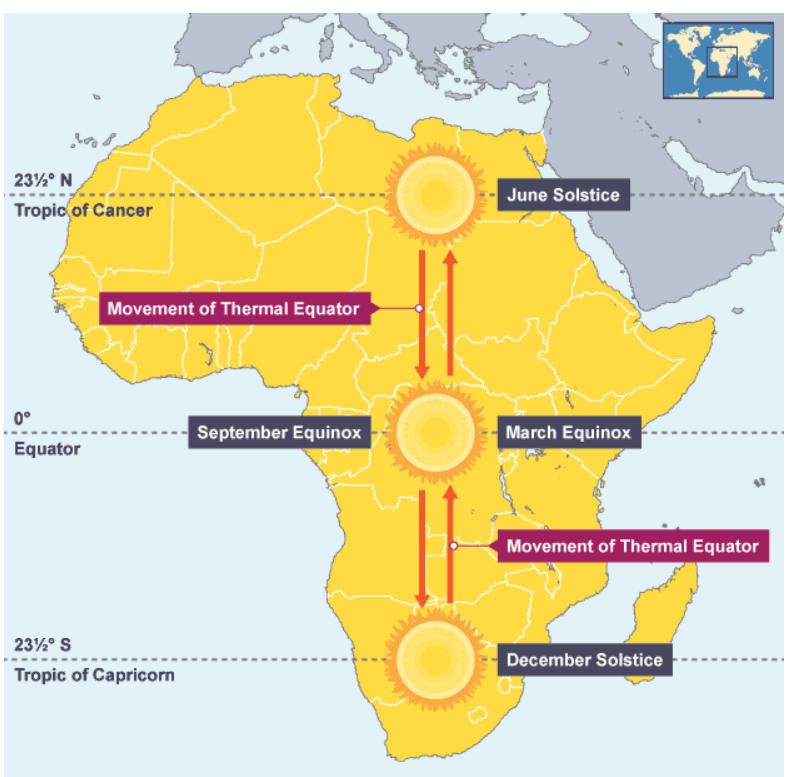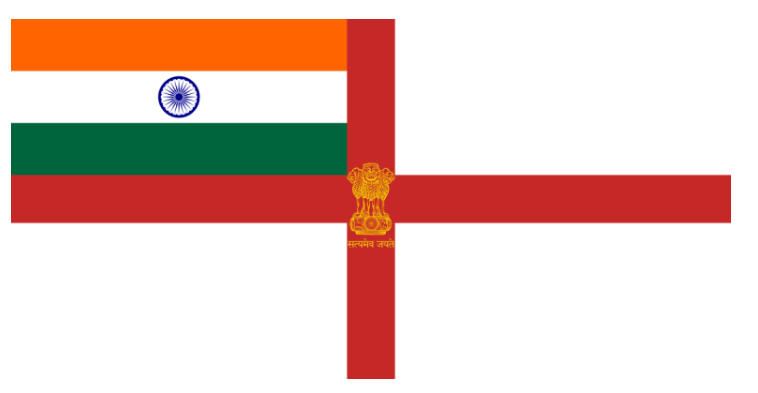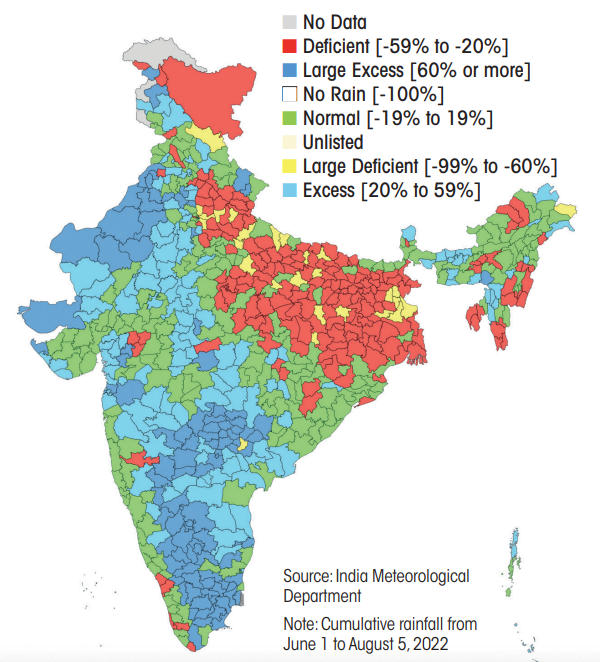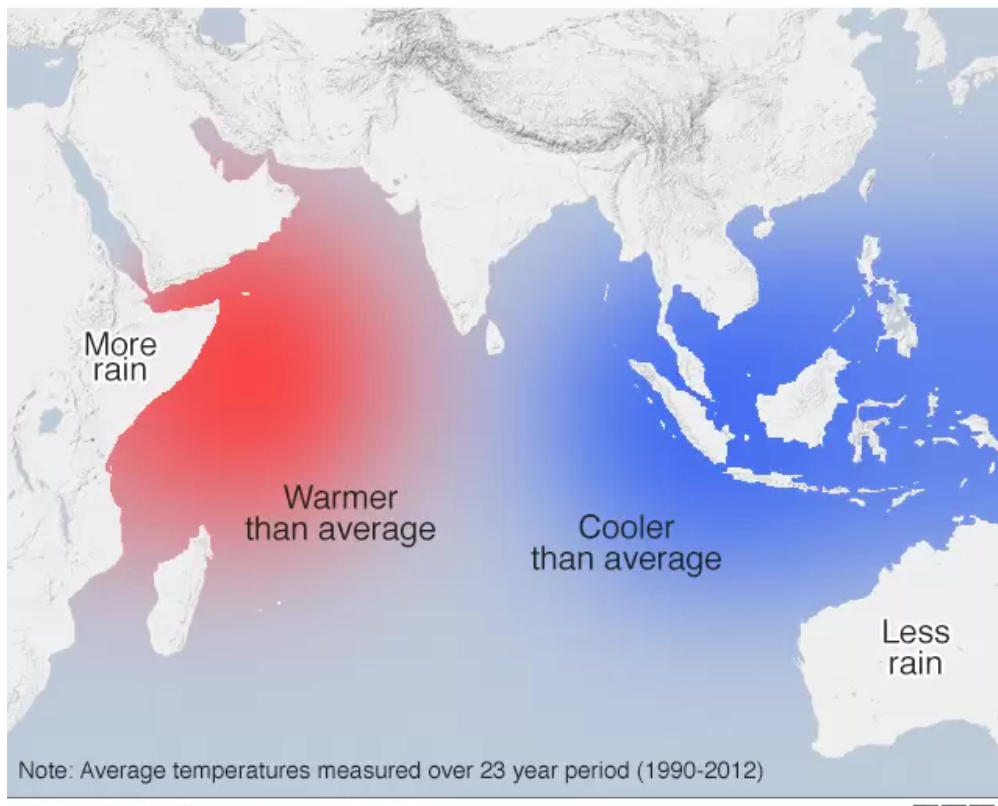Table of Contents
What is Inter Tropical Convergence Zone?
Why in news?
ITCZ could be a major reason for excessive rainfall in PAK along with Climate Change.
What is ITCZ?
- The ITCZ is a zone of convergence at the thermal equator where the trade winds meet. It is a low pressure belt and migrates with the changing position of the thermal equator.
- The thermal equator receives the most intense heat from the Sun. Around 20th June each year the Sun is overhead at 23½º North, the Tropic of Cancer. Around 20th December the Sun is overhead at 23½º South, the Tropic of Capricorn.
- The movement of the thermal equator shifts the belts of planetary winds and pressure systems to the north and to the south annually, as the diagram below shows.
Indian Navy’s Ensign
Why in news?
Prime Minister Narendra Modi will unveil the new naval ensign (flag) for the Indian Navy in Kochi on September 2 on the sidelines of the commissioning of India’s first indigenous aircraft carrier INS Vikrant at Cochin Shipyard Limited.
What will be changed?
- It will replace the present ensign that carries the Saint George’s Cross with the Tricolour in the canton (top left corner of the flag).
- This ensign is essentially a successor to the pre-Independence ensign of the Indian Navy which had the red George’s Cross on a white background with the Union Jack of the United Kingdom on the top left corner.
- The design of the new ensign has not yet been made public.
What is the Saint George’s Cross?
- The red cross on white background is known as the Saint George’s Cross and is named after a Christian Warrior Saint who is believed to have been a crusader during the third crusade.
- This cross also serves as the flag of England which is a constituent of the United Kingdom.
- The flag was adopted by England and the city of London in 1190 to identify English ships entering the Mediterranean.
- The Royal Navy adopted the George’s Cross to fly on their ships in various shapes and forms and the present pattern of the British White Ensign (as it is known) was adopted around 1707.
Mikhail Gorbachev
Why in news?
Figures from across the world are paying tribute to Mikhail Gorbachev who recently died in Moscow at the age of 91.
Who was he?
- Gorbachev was the last leader of the Soviet Union – from which modern Russia emerged – and is best known for opening up the USSR to the world.
- Many Russians blame him and his policies for the collapse of the Soviet Union in 1991 – which Vladimir Putin sees as a historic mistake
- The head of the UN said Gorbachev “changed the course of history”, while US President Joe Biden called him a “rare leader” who imagined a different future for his country
- Kremlin spokesman Dmitry Peskov says he was a statesman who will go down in history but that his romanticism about relations with the West “did not work out”
- Gorbachev will be buried in Moscow’s Novodevichy Cemetery next to his wife Raisa, who died in 1999
India’s Updated NDCs
Why in news?
The Union Cabinet on August 3 approved the country’s updated Nationally Determined Contributions (NDCs) to cut carbon emissions in accordance with the 2015 Paris Agreement.
About updated NDCs
- The updated NDCs include achieving 50 per cent cumulative electric power installed capacity from non-fossil fuel-based energy resources, by 2030.
- They also highlight changing lifestyles to tackle climate change.
What is a Nationally Determined Contributions?
- An NDC, or Nationally Determined Contribution, is a climate action plan to cut emissions and adapt to climate impacts. Each Party to the Paris Agreement is required to establish an NDC and update it every five years.
- NDCs are where countries set targets for mitigating the greenhouse gas emissions responsible for causing climate change and for adapting to climate impacts.
Dry monsoon for east, northeast
Why in news?
East and North-east India may continue to see a deficit of rainfall in August and September this monsoon season, as per the recent analysis by the India Meteorlogical Department (IMD).
Key Points
- Most parts of the regions have been receiving below normal rainfall since June.
- July rainfall, 44.7 per cent less than normal, was the lowest in 122 years, says imd. A deficit is also evident in Kerala.
- Despite seeing heavy rainfall and flood alerts during the first week of August, districts in the states showed a seasonal deficit of 15-25 per cent, as on August 5.
- One of the reasons for this trend in rainfall across the country could be the development of a negative Indian Ocean Dipole event which generally has a dampening impact on rainfall patterns.
Countrywide Normal Monsoon
- IMD predicts normal rainfall for the country as a whole, with a break in the monsoon bringing rains to northwestern India earlier this month.
- In July, four low-pressure areas also brought rainfall to central and western states, even Gujarat, Rajasthan and Maharashtra.
What is dipole?
- The dipole is a climate phenomenon similar to El Niño
- The Indian Ocean Dipole – often called the “Indian Niño” because of its similarity to its Pacific equivalent – refers to the difference in sea-surface temperatures in opposite parts of the Indian Ocean.
- Temperatures in the eastern part of the ocean oscillate between warm and cold compared with the western part, cycling through phases referred to as “positive”, “neutral” and “negative”.
- Extreme climate and weather events caused by the dipole are predicted to become more common in the future as greenhouse gas emissions increase.
How soil can fight emissions?
Why in news?
If fossil fuels account for two-thirds of the world’s harmful emissions, misuse of soil covers the other one-third, the public body responsible for Scotland’s natural heritage, said days ahead of the 22nd World Congress of Soil Science held in Glasgow on July 31-August 5.
About World Congress of Soil Science
- The week-long conference included discussions, demonstrations and presentation of research from 1,600 scientists from across the world.
- The aim was to address reversal of transformation of food production systems and land-use change that had an adverse impact on soil.
- Earlier a study led by California, US-based Lawrence Livermore National Laboratory, published in the journal Nature Communications, shows that regions with deep soil layers and those under proper agricultural management (with sustainable practices) show the greatest potential for carbon storage.
Rashtriya Poshan Maah 2022
Rashtriya Poshan Maah 2022- Relevance for UPSC Exam
- GS Paper 2: Governance, Administration and Challenges
- Government policies and interventions for development in various sectors and issues arising out of their design and implementation.
Rashtriya Poshan Maah 2022 in News
- The Ministry of Women and Child Development is celebrating the 5th Rashtriya Poshan Maah 2022 from 1st to 30th September 2022.
Key Points about Rashtriya Poshan Maah 2022
- About: Rashtriya Poshan Maah serves as a platform to bring focus to the discourse of nutrition and good health.
- Aim: In the 5th Rashtriya Poshan Maah the aim is to convert Jan Andolan into Jan Bhagidari to fulfill the Hon’ble PM’s vision of a Suposhit Bharat.
- Objective: This year, the objective of Rashtriya Poshan Maah 2022 is to trigger Poshan Maah through Gram Panchayats as Poshan Panchayats with key focus on “Mahila aur Swasthya” and “Bacha aur Shiksha”.
- Parent Ministry: Ministry of Women and Child Development is responsible for Organizing the Rashtriya Poshan Maah 2022 in cooperation with States/UTs and Local Governments.
- Key Activities: In order to realise the vision of ‘Swasth Bharat’, the month long Rashtriya Poshan Maah 2022 event will witness intensive activities across the country for awareness about nutrition at the ground level through-
- Sensitization drives,
- Outreach programmes,
- Identification drives, camps and fairs with special focus on pregnant and lactating women, children below six years and adolescent girls.
- Awareness Drives: Awareness drives on Anganwadi Services and good health practices will also be organised.
- Growth Measurement drives will be conducted to bring more beneficiaries under the ambit of Anganwadi Services.
- Growth Measurement drives under Swasth Balak Spardha will be conducted by States with the help of AWWs, AWHs, ASHA, district functionaries and agencies such as Lions Club, Rotary Club etc.
- Health camps for anemia check-ups will be especially organised at AWCs for adolescent girls.
Rashtriya Poshan Maah 2022 at Various Level
- National Level: A national level toy-creation workshop will be organized to promote use of indigenous and local toys for learning in Anganwadi Centres.
- State Level: Under the State – level activities, ‘Amma ki Rasoi’ or Grandmother’s Kitchen of traditional nutritious recipes will be organised.
- Extensive efforts will be made to link traditional foods with local festivals during the month.
- State/UT women and child development depts. through its functionaries, will carry out various thematic activities and spread the message of the importance of holistic nutrition throughout the month to ensure a healthier future for women and children.
- Panchayat level: awareness activities will be conducted by local functionaries under the guidance of the concerned District Panchayati Raj Officers and CDPOs.
- Poshan Panchayat Committees will work closely with field level workers (FLWs) – AWWs, ASHAs, ANMs.
- This is to support problem solving and enabling service delivery through Anganwadi Centres (AWCs), Village Health and Nutrition Day (VHNDs), and other relevant platforms.
- The aim is to ensure all pregnant and lactating women, children below six years, and adolescent girls receive basic Integrated Child Development services.
POSHAN Abhiyaan
- About: POSHAN Abhiyaan is Government of India’s flagship programme to improve nutritional outcomes for children under 6 years of age, pregnant women and lactating mothers.
- POSHAN Full form: Prime Minister’s Overarching Scheme for Holistic Nutrition Abhiyaan
- Mandate: POSHAN Abhiyaan aims to address the challenge of malnutrition in a mission-mode.
- Mission Poshan 2.0: Focusing on the aims of POSHAN Abhiyaan, Mission Poshan 2.0 (Saksham Anganwadi and Poshan 2.0) has been launched.
- It is an integrated nutrition support program to strengthen nutritional content, delivery, outreach and outcomes with focus on developing practices that nurture health, wellness and immunity to disease and malnutrition.
Rang Swadheenta
Rang Swadheenta- Relevance for UPSC Exam
- GS Paper 1: Indian History- Indian culture will cover the salient aspects of Art Forms, Literature and Architecture from ancient to modern times.
Rang Swadheenta in News
- Recently, Sangeet Natak Akademi celebrated Rang Swadheenta to mark the celebration of 75 years of India’s Independence.
Rang Swadheenta
- About: Rang Swadheenta is a festival to cherish the memories of freedom fighters who laid down their lives to free India from the shackles of imperialism.
- Venue: Rang Swadheenta festival was held at Meghdoot Auditorium from 27th to 29th August , 2022.
- Organizing Body: Rang Swadheenta festival was organized by Sangeet Natak Akademi.
- Participation: A total of twelve teams and around hundred artists from nine States of India participated in the Rang Swadheenta festival.
- Focus Area: Rang Swadheenta Festival 2022 was unique in that it focused on folk singing styles.
- Rang Swadheenta showcases folk musical traditions from across the country.
Sangeet Natak Akademi
- About: Sangeet Natak Akademi was set up in 1953 for the preservation and promotion of the vast intangible heritage of India’s diverse culture expressed in forms of music, dance and drama.
- Sangeet Natak Akademi is the apex body in the field of performing arts in the country.
- Location: The registered office of the Akademi is at Rabindra Bhavan, 35 Feroze Shah Road, New Delhi.
- Parent Ministry: Sangeet Natak Akademi is an autonomous body of the Ministry of Culture, Government of India.
- Sangeet Natak Akademi Awards: They are the highest national recognition conferred on practising artists.
Sangeet Natak Akademi- Constituent Units
Sangeet Natak Akademi now has three constituent units, two of these being dance-teaching institutions-
- Jawaharlal Nehru Manipur Dance Academy (JNMDA) at Imphal: JNMDA has its origin in the Manipur Dance College established by the Government of India in April 1954.
- Funded by the Akademi since its inception, JNMDA became a constituent unit of the Akademi in 1957.
- Kathak Kendra in Delhi: Kathak Kendra is one of the leading teaching institutions in Kathak dance.
- Located in Delhi, it offers courses at various levels in Kathak dance and in vocal music and Pakhawaj.
Kathak Dance | Indian Classical Dances
CAP based Integrated Alert System (SACHET)
CAP based Integrated Alert System (SACHET)- Relevance for UPSC Exam
- GS Paper 3: Science and Technology- Developments and their applications and effects in everyday life.
- GS Paper 3: Disaster Management: Disaster and disaster management.
CAP based Integrated Alert System (SACHET) in News
- C-DOT (Centre for Development of Telematics) and (NDMA) National Disaster Management Authority, Government of India are jointly conducting an All India Workshop centered on Common Alerting Protocol (CAP) based Integrated Alert System -सचेत.
- C-DOT is the premier R&D centre of the Department of Telecommunications (DoT), Ministry of Communications, Government of India.
- SACHET System aims to provide a platform to the concerned departments and various disaster management agencies across India to discuss their underlying issues and challenges.
- It will help evolve the technology-based solutions to address issues and challenges in an effective manner.
CAP based Integrated Alert System (SACHET)
- About: Integrated Public Alert System-सचेत, is an early warning platform based on ITU’s Common Alerting Protocol (CAP).
- Development: CAP based Integrated Alert System (SACHET) has been developed by C-DOT for effective disaster management.
- Mandate: The SACHET platform has been widely used by National and State Disaster Management authorities for dissemination of alerts, advisories and other useful information to the massses on all available media during emergencies like floods, cyclones and Covid pandemic.
- Implementation: The SACHET system is already operational in 34 States and UTs.
- More than 75 Crores SMSes have already been sent by the SACHET system during various disasters like Cyclones (Asani,Yass, Nivar, Amphan), Floods (Assam, Gujarat), Lightning (Bihar), etc.
- The SACHET system has also been used to facilitate the pilgrims during Amarnath Ji Yatra.
Importance of SACHET Platform
- CAP based Integrated Alert System (SACHET) provides a converged platform for dissemination of targeted alerts to people in vernacular languages through SMS.
- As a one-stop solution and a concrete step towards realizing Hon’ble Prime Minister’s 10 point Agenda for Disaster Risk Reduction.
- Soon messages will be disseminated over all available communication media including, Cell Broadcast, Radio, TV, Siren, Social Media, Web Portal and Mobile Application.








 TSPSC Group 1 Question Paper 2024, Downl...
TSPSC Group 1 Question Paper 2024, Downl...
 TSPSC Group 1 Answer key 2024 Out, Downl...
TSPSC Group 1 Answer key 2024 Out, Downl...
 UPSC Prelims 2024 Question Paper, Downlo...
UPSC Prelims 2024 Question Paper, Downlo...




